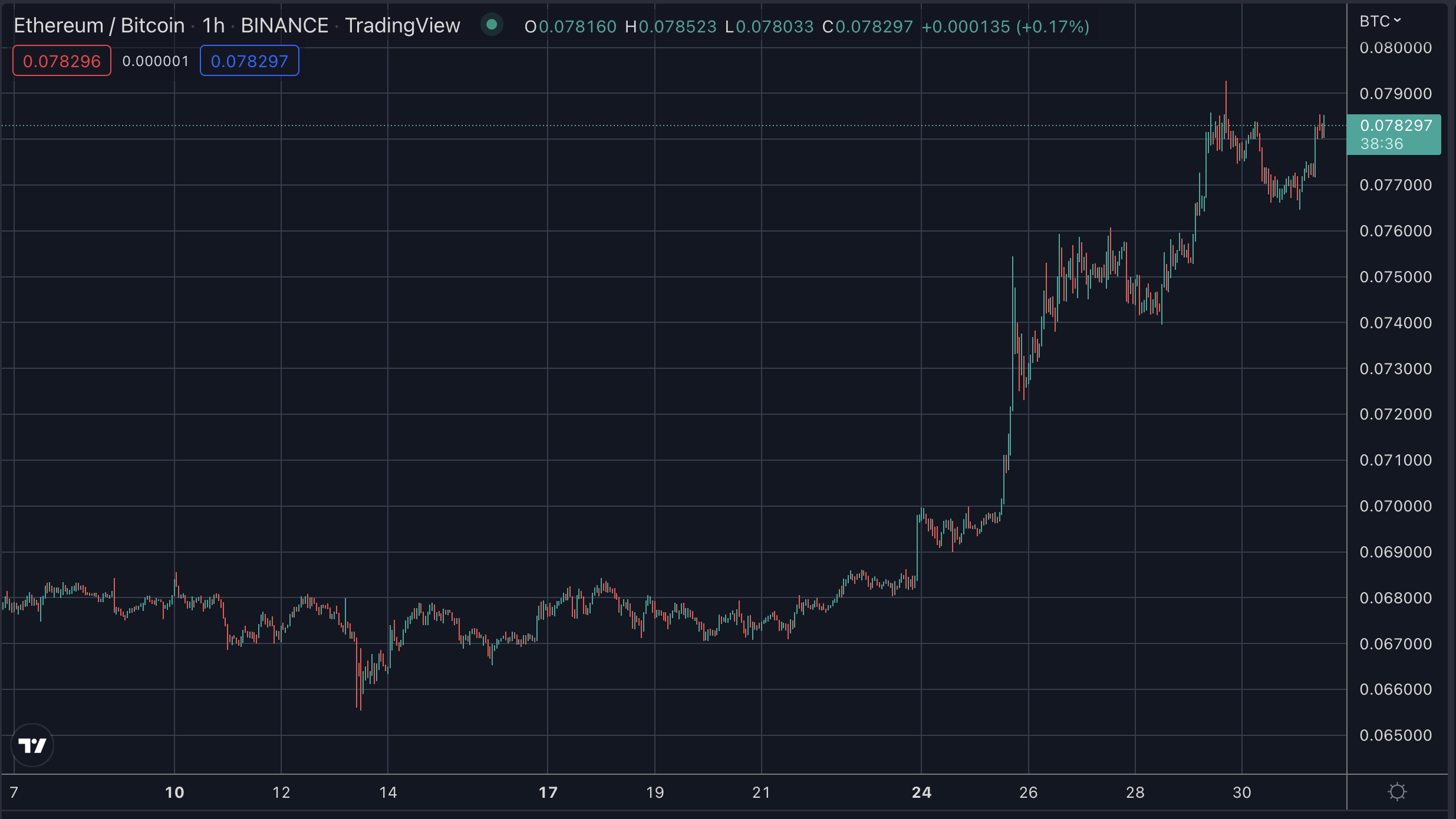Raoul Pal, a former hedge fund manager now running the Global Macro Investor, has turned very bullish on ethereum’s value in relation to bitcoin (the ratio).
“Is the ETH/BTC ratio the single most bullish major asset price chart in the world?” – he asked while sharing the above picture, before answering himself: “Might well be.”
Ethereum has suddenly gained some significant value against bitcoin. After sidewaying at 0.067 BTC, it jumped to near 0.08.

The ratio fell after the merge, but its recovery has grabbed attention in the past few days as it coincides with ethereum’s supply also falling by about 10,000 eth ($16 million).
Bitcoin has added $860 million worth of 41,000 BTC to its supply more than eth since the merge six weeks ago, and coincidentally eth would have added about as much, $890 million worth of 550,000 eth, if the Merge had not gone through.
A billion in six weeks means $10 billion in sixty weeks, that’s about a year. Making these substantial sums especially when you consider that they’re not dormant or hodl coins.
These would have instead gone to miners, who need to cover costs, and sometime might have to speed sell because they’re facing bankruptcy like Core Scientific.
This thus removes what we call practical supply, or price setting supply, and all else being equal it should at some point be reflected especially in regards to the ratio.
Arguably it already has. Ethereum has held its value far better against bitcoin this bear than during the last bear, and has been more bullish than bitcoin recently during this disbelief mini-rally.
Its inflation rate of pretty much zero, compared to bitcoin’s 1.7%, may well continue that extra bullishness, but in theory bitcoin doesn’t have any inflation as it has a cap of 21 million coins. In practice, its inflation rate runs at about $1 billion in six weeks.
Bringing us back to that pricing in, which arguably where the cap is concerned is pretty much impossible because no one can predict the future, and so how can you price it in.
That future can potentially include a removal of the cap. It wouldn’t be without a chain-split, but it wouldn’t be clear either just which side would win if there was such debate. Presumably whichever Cathie Wood chooses, with even Congresswomen now being bitcoiners and they may have a view too.
Ethereum, as far as reasonable expectations are concerned, doesn’t have any such uncertainty in the medium term.
The only way the current parameters are changed is if sharding for some reason requires more staking reward just because there would be more shards that require more stakers.
But first of all it isn’t too clear whether sharding – that is base layer parallelization of transactions – is achievable at all. And second, there are 14.6 million eth staking currently. At 100,000 eth, you get 140 shards.
There probably wouldn’t be any need to change the parameters and in any event sharding would change the burning by magnitudes.
The current aspiration instead is to eventually get zk-tech to the base layer, that’s compression at the base layer, for maybe 10x and – at max, though unrealistically anytime soon – 100x current transaction capacity.
That wouldn’t increase the burning by the same scale because it would compress transactions by the same scale. Well, it wouldn’t increase it in a technical direct manner. Presuming higher capacity attracts higher demand, then naturally there would be more demand for eth.
Bitcoin can’t easily be dismissed however. They have their own halvening hype coming on soon-ish with this space looking to see whether we’ll get some pricing in this time, and that will bring their inflation rate down to 0.8%.
Eth’s rate on the other hand depends on network usage, but even during these very low periods of activity it has amounted to nearly $1 billion off the otherwise supply.
In addition, whichever way you cut it, eth’s inflation rate has fallen from 4% to nearly zero. That’s from twice bitcoin’s inflation rate – though about the same in dollar amounts but bitcoin’s market cap is twice that of eth – to twice lower than bitcoin’s inflation rate.
That’s a huge change whichever way you look at it, and the ratio is reflecting it. Yet, there is a question of just how realistic the reflection is currently because stakers can not withdraw, and so they’re not quite having a say in the market.
The above figures account for the staking reward, with the inflation rate being near zero even with those staking rewards, but investors may wait to see just what these stakers do first and just how the asset reacts once stakers can participate in the market.
Any flippening therefore, if it develops at all, would probably be after the unlock period, but any ratio re-adjustment doesn’t necessarily have to wait because where both assets are concerned holistically, one has had a significant monetary change.
Source: https://www.trustnodes.com/2022/10/31/ethereums-ratio-most-bullish-chart-in-the-world-says-raoul-pal
